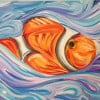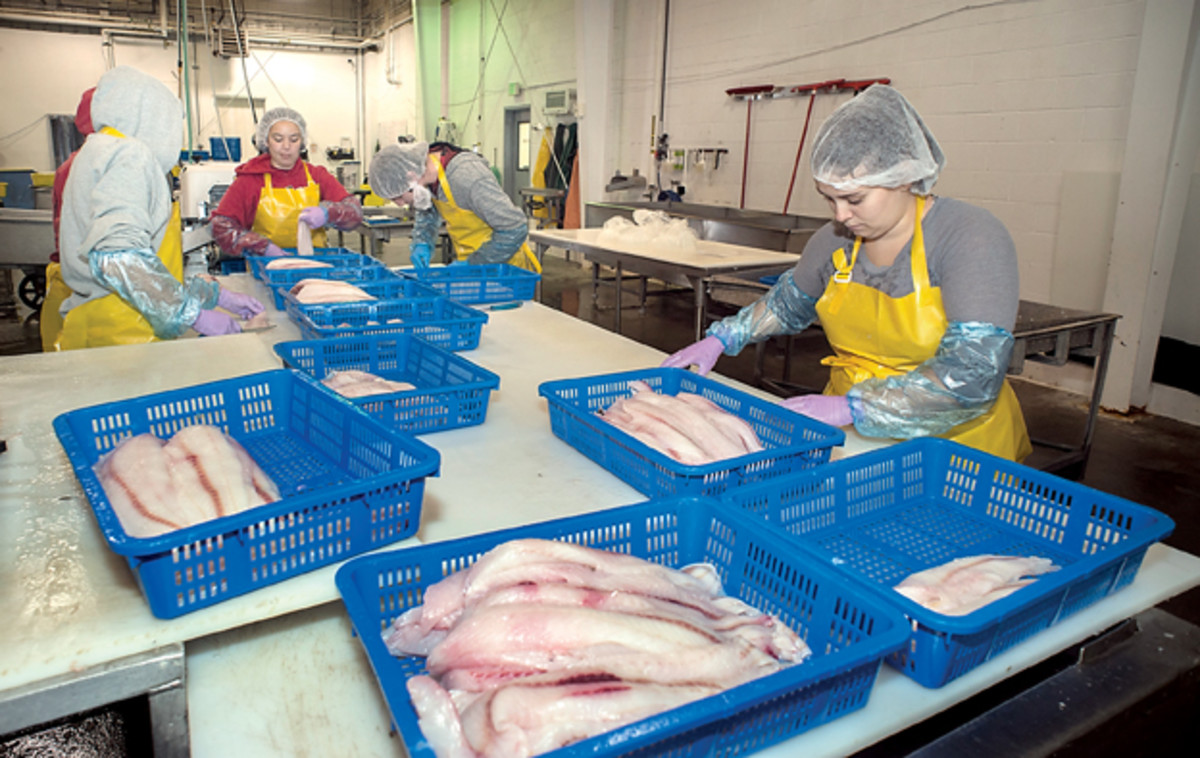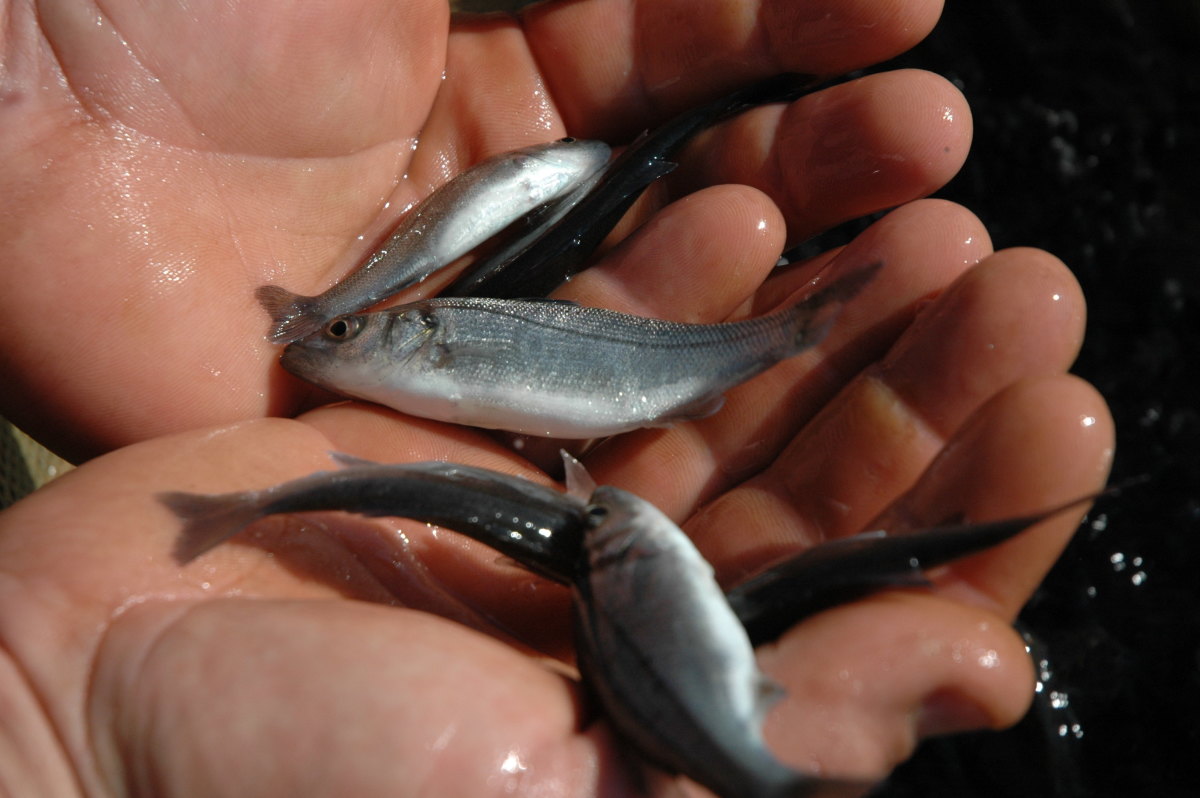Developing a Regulatory Regime for Aquaculture Products
Abstract:
As the U.S. population grows, so does the demand for seafood. Wild fisheries alone no longer have the ability to supply a sufficient amount of seafood in a sustainable manner. In order to meet the rising demand, the Department of Commerce and the National Oceanic and Atmospheric Administration (NOAA) have called for an increase in production from the domestic aquaculture industry. Increasing U.S. aquaculture would provide a domestic source of renewable seafood, subsequently allowing seafood production and distribution to be monitored more closely, promoting industry diversification, creating job opportunities, and contributing to keeping working waterfronts in business. An issue that could arise with the increase in aquaculture is the sale of undersized, wild-caught fish as cultured fish in the food distribution chain. The harvest and sale of these undersized, wild organisms prevents them from reaching maturity and spawning, thus threatening the sustainability of natural stocks. In order to protect these stocks from further damage and still provide safe, sustainable seafood, NOAA’s National Marine Fisheries Service (NMFS) is taking proactive measures to address this potential issue.
Natural resource enforcement officers currently lack an adequate field method for differentiating wild from farmed fish. Having a differentiation system in place would allow for more efficient enforcement of resource regulations. This would contribute to protecting and preserving our country’s natural resources while allowing fish farms to sell undersized fish without penalty. There is no practical reason to apply size limits to undersized farm fish because the larvae come from hatchery broodstock, so they are not removed from the wild, and marketing them has no direct negative impacts on the sustainability of wild stocks. There is also a market for plate-sized cultured fish, so requiring that these fish reach a larger size would increase the resources needed to feed, house, and transport larger fish.
This paper investigates regulatory strategies used by the U.S. and other countries and various methods for differentiating wild-caught and cultured fish. Differentiation of seafood products is done in the U.S. (for shellfish) and other countries with the use of physical tags containing simple labels on all seafood lots, often along with quick response codes or barcodes for organized data management. For this system to be effective for fish in the U.S., standards are needed to ensure reporting accuracy. If good record-keeping practices are observed and managed electronically in conjunction with a labeling system, products can be easily traced to identify suspected violations and help prevent future violations. If problems arise in the future, more reliable differentiation could be accomplished by supplemental use of chemical immersions such as calcein or oxytetracycline that induce external fluorescence being a requirement for all cultured food fish, though more research on the use of these methods is needed. These chemical immersions have been found to be comparatively cost-effective, enforceable, and generally reasonable. Since traceability systems are currently being used successfully in the seafood distribution chain elsewhere, it seems reasonable that these systems could be tailored to suit the immediate needs of U.S. enforcement; protecting natural resources while still allowing the sale of undersized cultured fish.
Introduction:
The demand for seafood is increasing in conjunction with the growing U.S. population and has reached a point at which it exceeds the available supply from wild stocks. To meet this growing demand, the U.S. currently imports more than 80% of the seafood consumed in the country and of this amount 50% is cultured. The U.S. aquaculture industry could provide a safe, consistent, and renewable supply of seafood to the population and thus mitigate dependence on foreign nations and promote domestic industry. The Department of Commerce and the National Oceanic and Atmospheric Administration’s (NOAA) National Marine Fisheries Service (NMFS) have set forth policies to encourage sustainable aquaculture practices and support industry development². As shown in figure 1, the catch from wild stocks remains relatively constant, with a slight decline as stocks deplete, while the harvest from cultured stocks continues to rise in response to the growing demand for seafood.
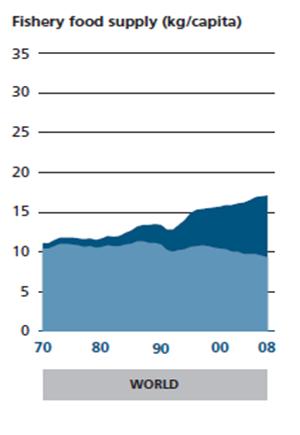
Increasing the amount of national aquaculture production will not only create job opportunities but also allow for more careful control of the safety and sustainability of seafood stocks by bringing production under U.S. regulation. The expanding presence of aquaculture will complement the fishing industry by providing a sustainable alternative to wild-caught fish while helping to protect and preserve the natural resources on which the fishing industry depends. In turn, this contributes to diversifying the industry and keeping working waterfronts in business.
NMFS is charged with the responsibility of protecting the integrity of our wild stocks. A potential issue that could arise is the sale of undersized, immature, wild-caught fish as cultured product in the seafood distribution chain (figure 2). There is no practical reason to apply natural resource size limits on fish raised in aquaculture facilities as the larvae originate from hatchery broodstock and therefore do not require the size limits needed for finite wild stocks. Cultured fish can thus be raised and sold below the size limits intended for wild-caught fish without any detrimental effects on wild populations or the environment. There is a market for smaller, cultured fish³, so requiring that they reach a minimum natural resource-based size limit before sale would increase associated costs. More resources (i.e. time, money, feed, water, etc.) would be needed for growing, holding, and shipping these organisms at a larger size. This results in increased expenses and a likely increase in market prices.
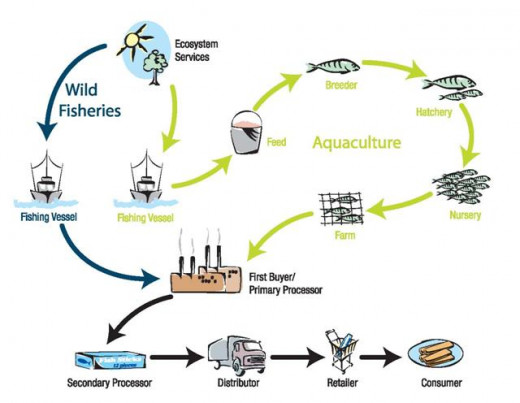
In order to avoid these potential issues as the industry grows, NMFS is taking proactive measures to ensure that proper regulations are in place that can be easily and effectively enforced. For this to happen, there must be cost-effective methodology for differentiating wild-caught from cultured fish in the field. There are not yet any distinguishing morphological characteristics to allow for differentiation as there has not been enough time for selective breeding to result in such characteristics. This poses a problem to resource enforcement officers attempting to enforce laws and regulations meant to protect wild stocks. This paper will provide an overview of the current methods for identifying and tracking food fish in both the U.S. and other countries, an analysis of these data, and will offer solutions and suggestions for improving the national system.
U.S. Enforcement:
In the U.S. there are two main acts that influence the regulation of the harvest, transportation, and sales of seafood: the Lacey Act and the Magnuson-Stevens Act. The Lacey Act states that it is unlawful to “import, export, transport, sell, receive, acquire, or purchase fish or wildlife that has been taken, possessed, transported, or sold in violation of fish and wildlife laws”⁵, which includes all fish under legal size limits. The laws regarding interstate commerce of fish often differ by state, so if you are transporting a fish legally in one state but cross through another in which the transport of that fish is illegal, then this is a violation of the Lacey Act. Prosecutions under this act usually occur as trafficking or false labeling violations⁵. The current sentences are as follows:
-Trafficking and mislabeling violations regarding wildlife with a total value less than $350 are considered misdemeanors. If convicted, the offender faces up to a one year prison sentence and/or a $100,000 fine ($200,000 fine if the offender is an organization) ⁵.
-Trafficking and mislabeling violations regarding wildlife with a total value greater than $350 are considered felonies. If convicted, the offender faces up to a five year prison sentence and/or a $250,000 fine ($500,000 fine if the offender is an organization) ⁵.
The other main act, the Magnuson-Stevens Act, is directed towards extending control of U.S. waters, removing foreign fishing activity in these waters, preventing overfishing, allowing overfished stocks to recover, and conserving and managing fishery resources⁶’⁷. With these goals in mind, management plans are developed by regional fishery management councils in order to protect species that are or could become threatened. Management plans may include regulatory guidelines such as minimum size limits, gear restrictions, and total allowable catch limits.
The responsibility of enforcing these national acts is a joint effort between the Fish and Wildlife Service (FWS), the Coast Guard, and NMFS’s Office of Law Enforcement (OLE). In order for these acts to be enforced practicably, criteria known as the Aquaculture Enforcement Precepts (Appendix) have been identified by OLE. The first is that regulations must be simple and easy to understand. Regulations should not be overly complicated, as the more intricacies a regulation contains, the more room there is for violators to identify faults and exploit loopholes in the design. Regulations should also hold true for an extensive period of time rather than constantly changing, as this makes them more difficult to both follow and enforce.
Secondly, regulations should be as few as possible. An overabundance of regulations causes unnecessary strain on both the industry and enforcement personnel. It presents more room for errors because enforcement personnel must memorize and have a thorough understanding of all regulations in order to enforce properly, and those in the fishing industry must do the same in order to avoid penalization.
Thirdly, products and their containers should be clearly marked. In order to better identify violations, products and their containers should have a distinctive form of marking that allows for easy differentiation between wild and cultured sources. This could be a written label or an electronic label such as a barcode or quick response (QR) code.
Fourthly, products must be accountable and traceable. Traceable implies that there is either paperwork or electronic records that track all relevant information from production and harvest to the retail level. This allows violations to be traced back to the source so they can be prevented entirely in the future. Accountability implies that the identification method of the product not be falsifiable nor allow for the commingling of different products (and subsequently, false labeling).
The final criterion for enforceability is that the regulatory scheme for aquaculture must be supported by appropriate penalties. Penalties should not be outrageous but should deter potential offenders. Similarly, repeat offenders or offenders in serious violation of regulations should receive an appropriately increased penalty.
Currently in the U.S., in order to transport commercial quantities of cultured fish, assuming that species has a management plan in place, a few preliminary actions must take place. The specific regulatory requirements vary from state to state, but there is a general protocol. First of all, to be able to culture, transport, or sell food fish, one must acquire the appropriate permits from state authorities. The transporter must also contact the authorities in each state that the transport vehicle will travel through, whether or not there will be stops, and get permission to ship the product through that state. If those permissions are granted, the receiving state then contacts the local enforcement agency and declares the quantity of fish being received. The state may drop the responsibility of the receiving state if fish are tagged individually with specific information such as the species name, place of origin, harvest date, lot number, production code, and fish number⁸. If the fish being transported are juvenile, permits are issued on a case-by-case basis. The quantity being moved must be stated and is recorded on the permit.
Enforcement is, as stated before, a joint effort between FWS, the Coast Guard, and OLE. OLE officers and agents make a conscious effort to work cooperatively with the fishing industry. There is some natural tension between NMFS and the fishing industry, but this comes with regulating an industry and is unavoidable. If a member of the Coast Guard or a wildlife official notices suspicious activity, they alert OLE. OLE then conducts an investigation and, depending on the situation, an inspection. If a violation is detected, the enforcement officers may seize the catch and/or prepare a case report to be submitted to the NOAA General Counsel for prosecution. Inspections are also conducted at ports on a routine basis to ensure general compliance. OLE attempts to maintain a presence at the docks to deter illegal activity, but the extent to which this can be done is restricted by staffing limitations.
OLE consists of only 130 or so officers and agents nationwide, which must be kept in mind when deciding if a regulation is reasonably enforceable. Enforcement techniques that require a high number of staff or a large amount of staff members’ time pose difficulties. As there is such a large area along the coast to patrol, it is unreasonable to ask that every ship and port be monitored regularly. OLE is responsible not only for enforcing the Lacey Act and the Magnuson-Stevens Act but also other statutes, including but not limited to: the Endangered Species Act, the Marine Mammal Protection Act, and the Atlantic Coastal Fisheries Cooperative Management Act.
Traceability in the U.S.:
A solid traceability plan in conjunction with a way to easily differentiate sources of fish will allow for effective enforcement of regulations. A working model for traceability exists in the U.S. from the Interstate Shellfish Sanitation Conference (ISSC). The ISSC aims for total traceability through the use of a paper records trail for tracking product movement in conjunction with proper product labeling which together allow the product to be traced from the consumer back to the harvester. Though this agency’s efforts are targeted towards providing safe shellfish products to consumers, it seems reasonable that its methods could be applied to differentiate cultured from wild fish.
To conform to ISSC requirements, someone wishing to ship shellfish must first submit a request to the state shellfish sanitation control authority and their facility must receive a shellfish sanitation certification inspection by trained personnel. These inspections are repeated at least once per year and all certified shippers are published monthly in the Interstate Certified Shellfish Shippers List (ICSSL). All interstate shipments must be accompanied by a bill of lading which includes the shipper’s name, address, certification number, point of origin of the shipment, type of product, quantity, and date of shipment. If a bulk lot of shellfish undergoes a change in custody, even if in-state, a transaction document must be submitted to the authorities describing the specifics of the transaction prior to the shipment. Additionally, lots must be labeled in accordance with Food and Drug Administration (FDA) and National Shellfish Sanitation Program (NSSP) requirements. Each lot of shellfish must have an approved, durable, waterproof label containing the following information: dealer’s name, address, and certification number, harvester identification number or original shellfish shipper’s certification number, harvest date, state and area of harvest, and the type and quantity of product (figure 3). The label is also required to state “THIS TAG IS REQUIRED TO BE ATTACHED UNTIL CONTAINER IS EMPTY AND THEREAFTER KEPT ON FILE FOR 90 DAYS”. The ISSC has found that some people are hesitant to participate honestly in this program because they do not want to share information that could potentially reduce business by identifying themselves as middle-men. Through the use of electronic tracking systems such as Trace Register™ and ScoringAg, sensitive information can be hidden to cater to those requests. The information safeguard can of course be overridden for security reasons by authorized personnel. Implementing these systems requires only the cost of the system, as no hardware or software is necessary, merely internet access or a smart phone. An ISSC representative also mentioned that people can be hesitant to label retail-sized packages. Retailers want the ability to discard portions of these packages if the products inside degrade at different rates. As long as the label is adjusted accordingly, this poses no threats to traceability. However, the ISSC does discourage commingling of products because that makes it harder to identify the source.
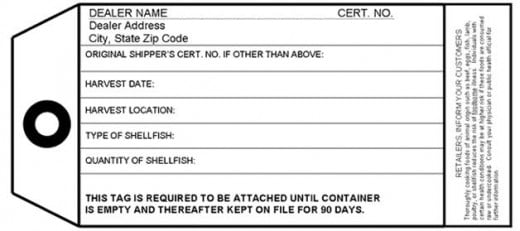
The Marine Stewardship Council (MSC) uses traceability to benefit not only consumers and enforcers, but retailers as well. They have developed a certification system that provides assurance to the buyer (or investigator) that all fish with their label come from a sustainable fishery. A recent study found that out of 196 samples of MSC-labeled products tested, 192 of them were labeled correctly¹⁰. Any business wishing to sell seafood with an MSC label must have an approved traceability system in place that tracks relevant information from retail to harvest. By having an MSC label, retailers can verifiably market safe, sustainable seafood to their customers, opening them to a larger, higher-end market. By knowing the source of the food, retailers can charge higher rates for preferred foods and can identify sources of poor quality foods. Effective traceability systems also allow for more efficient recalls if there is a food safety issue. Having MSC credentials contributes positively overall to a seller’s reputation.
Food traceability is also governed by the Bioterrorism Preparedness and Response Act. This act has regulations requiring the establishment and maintenance of records throughout the supply chain and the availability of these records. Unfortunately, this act does not cover traceability requirements for fish farms, fishing vessels with fewer than 10 full-time employees, or restaurants, so traceability requirements in the U.S. currently only exist on a voluntary basis for eco-labeling certifications (MSC) and as a requirement for shellfish distribution (ISSC).
While traceability plans are a great supplement to preventing illegal fish sales and investigating violations, proper policies must be in place to assure that all necessary information is submitted accurately and on time. There also needs to be a common nomenclature system established as there are often many names for the same fish, or many fish with the same name. Consistent use of scientific names would be optimal. A form on which the required data is simply laid out and submitted, ideally electronically to avoid the burden of paperwork storage and restricted access, would be of great benefit. All submissions should be sent in soon after a transaction is completed in case the information is needed by authorities. If submissions are missing when expected, an automated electronic notification could be sent to the provider of the information and, if still not received, to the authorities to ensure that this information does get provided. The presence of enforcement personnel at ports and observers on board would help to ensure that information is reported accurately. Though it is not always possible to uphold this presence, the chance of occasional surveillance would be enough to deter many violators. Coupled with regular inspection of market areas and strict enforcement of regulations, traceability requirements will start to be taken more seriously.
Foreign Strategies:
Another working model of a traceability system can be obtained from The European Commission (EC), which in August of 2010 published an article detailing the current policies of the European Union (EU) regarding the regulation of fisheries and aquaculture farms, the effectiveness of these policies, and considerations for alterations and additions to these policies¹¹. The current protocol for ensuring accurate traceability in the EU is a multi-step process that requires cooperation from various sectors of the fishing industry, aquaculture industry, law enforcement, and regulatory agencies. The process starts at the source of the fish. If the source is a wild one, as soon as the fish are hauled on board, the captain is supposed to submit a “catch declaration” to the control authorities. This includes information about the estimated quantity, date and zone of catch, gear used, the vessel’s home port, and the start and end dates of the season for each species caught. This data is required to be submitted electronically if the vessel is 12 or more meters long, otherwise a paper logbook is kept and submitted every two days. If product is moved to another vessel for any reason, the captains of both the harvesting vessel and the receiving vessel must submit a “transshipment declaration” to the control authorities as well. This documentation contains the identity of the vessels, a description of the product, and the destination. If the source of fish is an aquaculture farm, the process starts when the fish are divided into sale lots.
Once an aquaculture farm delivers their shipment or a boat reaches the port, the fish are divided into lots based on species and must then be weighed upon landing on a scale that has been approved by control authorities. This is usually performed by the auction center at which the fish will be sold, but can also be done by the producer’s organization to which the incoming vessel belongs to, or if it is a direct sale, by the buyer. The lots are then labeled, often in the form of a barcode or an electronic chip that states the lot identification number, the identity of the fishing vessel or aquaculture farm, the species (including international code, commercial name, and scientific name), the catch dates, the catch/harvest zone, the exact quantity, and whether the fish have been frozen or not. After landing and weighing, a “landing declaration” must be submitted by the harvester, dictating the species, quantity, and the port of landing. If possession of the products is transferred to the auction center or any other organization until sale time, a “take-over declaration” must be submitted within a day or two as well.
Once at the auction, in order to be eligible to purchase wild or cultured fish, the buyers must be approved by the state and identified in a national list. Once a sale occurs, the seller issues an invoice and a sales note that is submitted to control authorities. The sales note identifies the buyer (often a wholesaler), the date and location of the sale, invoice references, and the price. The invoice and sales note must match and may be viewed by both fisheries inspectors and tax authorities. If the product is to be loaded into a transport vehicle, which would be the case for a direct sale, it may be authorized to leave port without a take-over declaration or a sales note on the condition that the transporter provides a “transport document” before leaving. This contains similar information to the other documentation but also includes the place and date of loading, destination, and the identities of the transporting vehicle and recipient. This must be submitted either electronically immediately or accompany the transporter in paper form to the destination and be submitted within 48 hours of unloading. If the wholesaler wishes to further divide or group together lots, the new lots must be labeled with reference to the original lot. Once these lots have reached the retailer they must be labeled before being sold with the species name, type of production (wild-caught or farmed), geographical zone of catch/farm, and if sold in the fresh food department, whether or not they have been frozen before.
This system aims for total traceability of product from the retailer to the source fishing vessel or farm with the use of an in-depth records trail that can be submitted and monitored electronically. Traceability offers a way of investigating potential violations and even offers a certain degree of prevention because offenders know they can be tracked. There will always be room for errors in reporting to occur, but the EU system appears to minimize this.
In Canada, providing effective enforcement of fishery and aquaculture laws consists of three main activities¹², the first of which is education and shared stewardship. This includes a plan targeted towards educating industry members and the general public about conservation and resource management through awareness activities and publications. Newsletters, websites, posters, and outreach events all help to bring knowledge about issues to the public’s attention. Shared stewardship involves working cooperatively with other countries and organizations to promote homogenous regulations and enforcement tactics. International cooperation is important to maintain consistency of enforcement and prevent violators from avoiding prosecution by crossing territorial boundaries. Cooperation also helps by dividing enforcement tasks up among nations, so responsibility is not solely that of any one nation. Since oceanic natural resources observe different territorial boundaries than people do, it makes sense that sustainability be a global rather than national effort.
The second main set of activities is monitoring, control, and surveillance. This consists of patrols carried out not only at sea, but on land and in the air as well. If a fishing vessel or culture facility is suspected of a violation, an inspection is performed by trained staff to ensure compliance. Officers may issue a warning, note the vessel or farm for future monitoring, report a violation to the local police, or take any other action deemed appropriate. The police agencies and wildlife enforcement personnel of Canada often work collaboratively in order to determine the best course of action in a given situation.
The third activity of importance to Canadian natural resource enforcement officers is investigating. Officers respond to complaints and suspicions by conducting relevant investigations. This step is critical because without follow-through, people will not take regulations seriously. Officers need to demonstrate that they are serious about enforcement and will tolerate nothing short of compliance (within reason, of course). Being consistent in this area is key to effective enforcement.
In addition to implementing a strong enforcement regime, Canada attempts to create a relevant set of regulations to provide the basis for this enforcement. Canadian fisheries and aquaculture management is regulated primarily by Fisheries and Oceans Canada (DFO) through the use of two main statutes: the Coastal Fisheries Protection Act and the Fisheries Act¹³. The Coastal Fisheries Protection Act is geared towards limiting foreign fishing in Canadian waters through a necessary permitting/licensing process¹⁴. This process applies to Canadians as well, requiring all individuals on a fishing vessel to own the proper permits or licenses for the type of fishing being done. It also gives the authority to enforcement personnel to search ships, seize illegal products, and arrest offenders if there is suspicion or knowledge of illegal activity. The Fisheries Act prohibits activities that negatively affect fish populations and their habitats and designates appropriate authority to enforcement personnel¹⁵. Regulations under these acts include gear, seasonal, and size restrictions, transportation requirements, and permitting regulations¹⁶.
Though not fully in place yet, Canada is developing a plan similar to that of the EU to increase traceability of seafood products, mostly in reaction to an increased consumer demand for nutritional and environmental safety. This plan stresses the importance of external traceability, that being traceability throughout the entire supply chain (figure 4). Internal traceability has more or less already been established through routine business recordkeeping practices such as inventory and purchase and sales notes. Canada does not currently require that cultured and wild fish be differentiated on seafood labels, though they do usually require that the country of origin, quantity, moisture content, and quality be included. Without reliable external traceability though, these labels lack trustworthiness. One barrier that prevents Canada from having stricter external tracking regulations is the effect that implementing a new traceability system has on small businesses⁴. The cost for setting up and maintaining the equipment and software necessary for a reliable tracking system can be significant. Requiring smaller businesses to participate could drive them out of business and eliminate healthy industry competition⁴. A cost effective way to collect, store, and manage records must be developed before absolute traceability can be a reality.
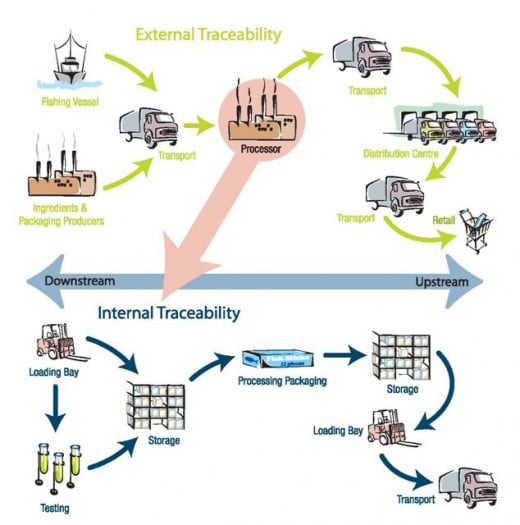
The traceability and enforcement plans of many other countries were researched but not all were included in detail in this paper. Australia and Japan’s strategies are similar to those of Canada and are in the process of being improved. Norway functions under many of the same regulations that govern the EU. One interesting thought is that Norway requires large vessels to house a satellite monitoring system that sends daily (or more often, if necessary) reports to the relevant authorities, making it easier to monitor fishing activities. Many of these countries also work cooperatively to standardize regulation and enforcement and to compile a list of vessels that have been found fishing illegally, making it harder for those vessels to land their catches worldwide. China has aquaculture and fishery regulatory systems but lacks adequate enforcement of many regulations and does not always practice sustainable fishing, though they too are working to improve their systems¹⁷’¹⁸. Likely as a result of this enforcement negligence, they suffer constant decreases in availability of natural resources and sometimes have difficulties selling products to the U.S. due to lack of traceability¹⁸. Most countries use some form of electronic or paper trail to allow for monitoring and investigations, but the effectiveness of this is dependent on the actions of enforcement agencies.
Methods of Seafood Identification:
Being able to differentiate cultured and wild product should ideally be a quick, easy process that can be carried out in the field. Methods that require laboratory resources, database references, dissections or significant time and effort of any sort are impractical field methods. With these parameters established there are a number of options for possible methods of differentiation including both long and short-term options. It is worth mentioning that eventually, through the process of selective breeding, cultured species will naturally develop noticeable differences from their wild counterparts. This has been the case in virtually every organism that has been cultured for extensive periods of time; domestic fowl have noticeably larger breasts and different coloration, domestic pigs are fatter and lack tusks, adult domestic sheep retain juvenile features, domestic goats have smaller horns, and the list continues. This is also the case for cultured fish species. Domestic goldfish hold little morphological semblance to their carp ancestors. Because of dietary differences, wild salmon have a different filet color than that of their cultured relatives, as do wild flounder¹⁹. Wild sea bream have visible differences in both body shape and external color when compared to cultured individuals²⁰. Hybridized striped bass have been developed to have broken stripes, while non-hybrid bass have solid stripes²¹. Differences inevitably arise when organisms are raised under the supervision of humans.
Similar morphological differences could be induced on a long-term basis through genetic modification. If an easily recognizable characteristic that is not reproducible can be genetically implanted in cultured fish, then differentiation would be simple and the characteristic would transfer to future generations without effort. This would eliminate the need for continued marking and reduce associated costs. A concern, other than time and money constraints associated with research, is public image. Despite the prevalence of genetically modified organisms in the food chain today, people continue to have a negative outlook towards the process and will often selectively choose against buying them.
Differentiation has been achieved in laboratory settings already using methods such as analysis of fatty acid proportions, total lipid content, trace mineral compositions, organic contaminants, stable isotopes, and genetic patterns (allozymes, mitochondrial DNA, microsatellite DNA)¹⁹’²⁰’²¹’²²’²³’²⁴. One program, aptly named FishPopTrace, is working towards developing a database of genetic information that can be used to determine not only if a fish is wild, but what waters a wild fish originated from. It has so far been successful with a few species, but much work still remains to be done. Some states require that aquaculture facilities gather a DNA sample from all broodstock²⁵. This is then sent to a lab for analysis and the data is stored by the aquaculture facility in case enforcement needs to identify offspring from future generations. While these methods offer reliable results, they are not practical on a short-term basis and are more suited towards criminal investigation needs as opposed to field enforcement needs. The method elected to satisfy the need for short-term differentiation will be dependent on the situation. For example, differentiation between fillets of fish is more difficult than differentiation between whole fish. Additionally, the available methods for marking live fish differ than those that are usable with processed fish.
The method of marking fish with the use of physical tags (often plastic labels) is commonplace in the aquaculture industry. Through speaking directly with industry representatives though, it became apparent that this method is far from ideal when marking live fish as each organism must be tagged individually. This increases labor costs because of the additional work and time required to tag all organisms individually. The sudden stress on the fish from the handling and tagging increases mortality rates as well. Additionally, the price of acquiring tags in bulk is expensive and must be compensated for in the wholesale price, subsequently driving up market prices. A possible solution to that issue exists in changing the material from which the tags are made, but this does not change the associated labor requirements or the negative effects on live fish. Research into engineering machinery that can expedite this process has been progressing, but the costs for such machinery at this time remain high. Marking dead fish with physical tags is a more reasonable option though as they do not require delicate handling and mortality is not a factor.
An inexpensive alternative to marking with tags is marking by disfigurement such as fin clipping or branding. Branding can be done in a variety of ways including physically with both hot and cold applications (though cold is generally more effective) and chemically using a silver nitrate pencil. Cold branding, also called freeze branding, is usually done by cooling silver, stainless steel, or copper with liquid nitrogen, Freon™, compressed CO₂, or dry ice and then pressing the metal against the exterior of the fish. This takes between one and five seconds per fish, depending on the species. While these methods are relatively inexpensive, they still require intensive handling, induce fish stress, and possibly damage the fish. Automated fin clipping machines do exist, and there are groups that have mobile clipping facilities that can provide this service for fish farms for a fee. Both of these options do increase expenses, but are still possibilities. It should be noted that pieces removed from fins can sometimes be regenerated and brands may heal over, so these markings are temporary. It is thus important to mark the fish right before sale so that the marks can be easily identified. Fin clipping may or may not affect survival rates as fish will become more prone to infection and fish may need the full fin for proper functionality. Other potential issues with fin clipping are that it requires anesthetics (increased costs, withdrawal time needed) and is easily reproduced. Branding could likely be done in a unique manner specific to the aquaculture facility, but if someone really wanted to, they could reproduce a brand as well. Another issue with fin clipping is that it is often performed on wild fish for research purposes, so the mark would need to be applied to wild fishes in the food distribution chain as well, which is undesirable. Placing the marks on wild fish means that the absence of the mark would identify the fish as cultured, leaving room for fishermen to falsify them. If the absence of the mark identified the fish as wild, there would be less room for error because there is no motive for culturists to falsify marks.
There are also laser technology systems that can be used for branding, but their costs and space requirements can be prohibitive. Unique physical marks could be made by FDA-approved marker pens too, though research would need to be done on retention rates. Marks made with marker pens may be too easily replicated to provide for reliable differentiation though.
Another possibility for differentiation is thermal marking of fish otoliths. The idea behind this technique is that by inducing an abrupt temperature change during egg incubation while the first calcified structures are forming, normal otolith development is disrupted and dark rings are created. Multiple rings can be created by repeating the marking process at different times during development, allowing for the creation of unique patterns that can be used to differentiate not only wild from cultured, but cultured fish from different farms. Since marking is done during incubatory stages, doing it on a large scale is not space or labor-intensive, though there are still considerable downfalls to this method. The process of acquiring the otolith for examination requires physically removing the otolith from inside the cranial cavity of the fish. This will likely not be appreciated by the enforcement officer that is required to do it or the retailer who may now be in charge of selling a legal, mutilated fish. The other problem with otolith marking is that differentiation requires a microscope and a grinder or sandpaper. While this type of equipment could be brought along in an enforcement vehicle, it does pose an inconvenience, requiring increased expenses and training. It is a possibility that temperature fluctuations during incubatory stages could negatively affect normal development of some species, though this is grounds for more research. Current research suggests that thermal marking does not significantly increase mortalities²⁶. On that note, there has been a large amount of research surrounding thermal marking and it has been tested and proven to be effective and safe for many species. Otoliths can also be marked with the use of dry marking, a method that induces dark rings by altering the water levels during incubation, though this may or may not affect development as well. A benefit of marking otoliths is that it is non-reproducible because the mark would be in a different location if a fisher marked a recently caught fish than if a culturist marked a young farmed fish.
Chemical markers can also be used to mark otoliths. Certain chemical markers cause the otolith of the fish to fluoresce, so mark identification is easier than with thermal or dry marking. Chemical immersion marking is when groups of fish are dipped or soaked in some sort of chemical marker solution. Examples of chemicals used for this purpose are oxytetracycline, tetracycline, chlortetracycline, strontium chloride, calcein, and various dyes (alizarin, trypan blue, Nile blue sulfate). These methods offer the significant benefit of being able to mark large quantities of fish in a short period of time with minimal effort and expenditure. The aforementioned chemicals have been used for research purposes with varying success rates, but there is always an underlying risk when using new chemicals in products intended for human consumption. Issues often arise when trying to get FDA-approval for chemicals used on food fish, as there are strict regulations regarding this.
The chemical calcein offers a reasonable possibility for marking live fish in the food industry. It works by entering the fish osmotically through tissue membranes and being absorbed by calcified tissues (scales, otoliths, rays, etc.), creating a permanent green fluorescent mark that can be seen under light of about 500nm²⁷. Western Chemical Inc., a manufacturer of calcein, sells a detector unit that is used to easily identify the presence of calcein in field samples. Calcein can be detected externally in the scales with the detector, eliminating the need to gather and analyze otoliths²⁸. These units currently sell for $1495, though this could change if calcein marking becomes common practice²⁸. Application is restricted to fish with a body weight of 2 grams or under, allowing for a sufficient withdrawal period before being sold as food. The immersion can be performed in two ways. One method calls for 125-250mg/L of calcein and an immersion duration between one and six hours depending on species, life stage, water temperature, and desired mark. The second method calls for a pretreatment in a 1-5% solution of non-iodized salt for about 3.5 minutes, then a treatment of 2500-5000mg/L of calcein for a duration between one and seven minutes²⁷. As of yet, calcein has not been observed to have any negative impacts on fish health and appears to be safe for human consumption after a grow-out period of at least a year²⁹. This product has yet to be FDA-approved but the FWS’s Aquatic Animal Drug Approval Partnership (AADAP) Program is working towards gaining approval.
The chemical oxytetracycline is a synthetic antibiotic in the tetracycline class that also holds potential for use as a live fish marker in the food industry. Oxytetracycline hydrochloride, a chemical used for marking immersions, is already FDA-approved for use with food fish in the U.S., which would contribute to the ease of implementing it as a standard. It functions in a manner similar to calcein in that it induces permanent fluorescence in calcified tissues including otoliths, scales, and rays³⁰.To mark organisms a bath is prepared usually containing 500mg/L of oxytetracycline and 1000mg/L of sodium chloride. Juvenile fish are then left in the bath for about six hours³¹. Once marked, they can be identified indefinitely by a yellow coloration that appears under ultraviolet light. This mark (or a calcein mark) would be difficult to reproduce accurately as the location of the mark on an individual marked in juvenile stages would be different than if an older fish was caught and marked the same way. The use of oxytetracycline does not increase fish mortality³¹’³² or negatively affect the growth of treated fish³³. One study³² observed a withdrawal time of 110 days, after which oxytetracycline was undetectable in edible tissues. It should also be noted that oxytetracycline is used successfully in human medical applications. When introduced intravenously to humans 250mg at a time, the drug had a half-life averaging between 8.5-9.6 hours and concentrations were considerably reduced after just twelve hours³⁴. This suggests that there is little accumulation of this chemical in non-calcified human tissues.
Oxytetracycline dihydrate, a similar FDA-approved marking agent, can be administered via feed, but this would imply that the fish receive the chemical in their grow-out area instead of a temporary holding tank. This is undesirable as antibiotics can have a detrimental effect on the beneficial bacteria needed for biological filtration in closed systems. The effect of these feeds in open systems would need to be investigated. Administering oxytetracycline this way would also require that the target fish be on a prepared food diet, which is not always the case. The use of any sort of antibiotic in food products raises concern among consumers, but by educating the public on the use of research-supported withdrawal periods this might be avoided. The fact that oxytetracycline products are FDA-approved provides additional assurance to consumers by letting them know that the safety of this drug has been researched, tested, and proven.
Fluorescence can also be induced by spraying fluorescent pigments on the scales. This, unlike chemical immersion induced fluorescence, is better suited for marking adult fish, not juveniles, as mark retention is usually higher in adult stages³⁵’³⁶. This method allows for mass-marking of fish with an easily identifiable, distinctive mark, low mortality rates³⁵’³⁶ and no detrimental effects on growth³⁵. The marking process must be tailored to the species being marked but this is not so much an issue since aquaculture facilities produce large numbers of the same species anyway. The implementation of this method would require some specialized technology to provide conveyor belt-like transportation of fish through the spray area, but the cost of marking after the required technology is established is low. An issue with any method that causes fluorescence is public perception. Consumers, whether or not they can actually see it, may be hesitant to accept the idea of glowing seafood, even if it is safe. By the time a fish has been processed and reaches its retail destination though, often it will not have the fluorescing parts anyway.
Any marking method will also require a labeling system to provide additional assurance that the fish has been identified properly. Labels can be a cheap, simple sticker on a lot container that provides critical information about the species, source, and destination. In addition to marking live fish lots, labels can be used to distinguish dead fish and processed fish products as well. Labels can be in the form of a barcode so that vital information can be accessed easily by scanning the barcode with a barcode reader. The information that can be stored with barcodes is limited, offering only about 50 bytes of data storage space. This information cannot be changed on-the-spot either, only by reentering the data and reprinting the barcode can new information be presented. Another consideration to be made is that if a barcode is damaged or dirty, it often cannot be read. QR codes could be used too and offer about 3000 bytes of storage space. A benefit of QR codes is that they can be read with a smartphone, so specialized technology could be avoided. QR codes can be used to connect the user to a website which would allow for simple data input and management. Another up-and-coming technology that could be used for labeling is Radio Frequency Identification (RFID) tags. These can hold several megabytes of data and do not need to be scanned manually, which allows for easier, more intricate traceability and differentiation than a barcode or QR code. RFID tags exist in two forms: active and passive. Active tags are equipped with their own battery power source and will automatically send out radio signals that can be read by an in-range (90+ meters) RFID reader, allowing for several tags to be read at once³⁷. This could be beneficial if for instance you were looking for all lots in a building that originated from a specific vessel that was believed to be selling undersized fish. Active tags sell for between $15 and $50 each, depending on the quantity and features³⁷. Passive tags do not have a power source and will transmit a signal upon receiving energy from a nearby (~6-12 meters) RFID reader³⁷. Neither of these tags requires a line of sight to be read as QR codes and barcodes do. Passive tags also have the benefit of being significantly less expensive than active tags, ranging from 10 cents to $4 apiece³⁷, which is still more expensive than barcode or QR labeling. Once a RFID tag is no longer needed, it can be removed and reprogrammed for another lot, reducing long-term costs related to labeling and promoting resource sustainability. A significant downfall of RFID tags is that radio interference can negatively affect the ability to read the tags³⁷.
Conclusion and Suggestions:
Allowing the sale of undersized, cultured food fish in the U.S. will require a combination of reasonably enforceable aquaculture and fishery regulations, consistent effective enforcement, and international cooperation. By using a mix of parts of the traceability plans of the EU and the ISSC, and the enforcement strategies of Canada, the harvest and sale of undersized fish can be more effectively managed in the U.S. A traceability plan would serve as a preventative measure and a means of investigation while using the enforcement strategies of Canada would establish a method for identifying and monitoring illegal activity. After doing extensive research and speaking with people from various sectors of OLE, industry members, ISSC representatives, and various other related parties, my suggestions for forward movement are as follows.
On a short-term scale, concentration needs to be directed towards developing standards for an external traceability system. Since the structure for working traceability systems already exists, we have the resources needed to address the issue now, we just need to make minor alterations to apply the system to fish in the U.S. Members of the fishing and aquaculture industries do not all currently use the same record-keeping systems, so data management is not yet fluid. Since increased traceability is already a goal of the Food and Agriculture Organization of the United Nations (FAO) due to the rising demand for food safety, resources could possibly be pooled to facilitate implementation. Using Trace Register™ or a similar user-friendly electronic record-keeping system that does not require the installation of costly hardware or software would allow a quality traceability plan to be implemented without incurring debilitating costs to small businesses. Though a paper trail could reasonably remain the standard for low-tech facilities, the gradual implementation of an electronic system would be highly beneficial to both enforcement and industry members. Using a digital record-keeping system as opposed to a paper one would reduce paperwork, required storage space, and the time and labor needed for filing. This in turn reduces supply and labor costs as online data storage is relatively inexpensive. It would also allow for more organized storage, easier access to data, simpler data management, and would contribute to the ease of standardization. Digital systems would also allow for a reporting system to alert industry members or officials when data is not being entered properly. The required input data could then be easily modified as need be so that it is in-depth enough to preserve the identity of the product and avoid regulatory loopholes but not cumbersome or tedious.
Effective traceability also includes the use of product labels. After cost-benefit comparisons of various methods, this paper suggests that labels be outfitted with both text and QR codes. The text portion will allow for easy manual identification and access to vital information in case of technological failures. The QR code will allow for in-depth identification as more data can be stored in the code than can fit on a label. QR codes will also allow for more efficient data management. Since these types of labels are printable and QR codes are free to create, the related costs are minimal. Retailers could also use QR codes to allow customers to look up right then and there exactly where the fish came from. If customers can visually see where their food is coming from, they become more comfortable buying it.
Implementing a traceability plan offers many other market benefits to the participants as well. Traceability helps to ensure customers that their product comes from a safe, sustainable source. With this knowledge available, retailers can reach higher-end markets and charge higher prices for more desirable products. Better traceability could also allow distributors to find out where and how much of their products are being bought, allowing them to more effectively market to their consumers. Enforcement would also be more prepared to monitor illegal harvests and sales in general, not just those related to undersized wild fish.
While a traceability system alone would be adequate, if there are still problems, enforcement officials could benefit from required marking of cultured fish. This would allow for more reliable identification of illegal fish products, provide stronger case evidence against violators, and generally make enforcement easier. Officers could then identify offences in the field without needing to search through records.
An ideal marking method should have certain characteristics in order to be practical for field differentiation. Most importantly, the mark needs to have duration long enough to last from the time of marking up until any point in the supply chain at which the fish would hypothetically be checked. The mark should be easy to identify, not necessitating extensive training or analysis, lab work, or inconvenient, expensive equipment. The mark should also be unique enough that it cannot be reproduced by someone trying to avoid regulation. The application of the marks should be quick, easy, and large-scale compatible to minimize associated costs and handling time in order to avoid stress and damage to the fish. Mortality rates should be low, and if marking juvenile fish, the health and development of the fish not negatively affected. A good marking system should also be inexpensive, both to implement and run on a long-term basis, and have high success and retention rates so that marking only needs to be done once and so that costs are not prohibitive to smaller businesses. Lastly, a marking method should be tested and proven effective and safe for human consumption by credible research (FDA-approved). An ideal mark should not, directly or indirectly, negatively affect the ability of a seller to market the product. There is currently no available differentiation method that encompasses all of these characteristics, so a method must be chosen that incorporates the most important ones.
With these parameters established, this paper suggests that the methods of calcein and oxytetracycline hydrochloride immersions be considered as a standard for marking juvenile cultured fish. These methods induce permanent and distinctive marks that have no significant negative effects on fish development, do not induce stress, cause no increase in mortalities, and pose no threat to human health if a proper withdrawal time is observed. These methods are relatively quick and easy, and are inexpensive even on a large scale, so aquaculturists have little reason not to comply. After speaking directly with some culturists it became apparent that immersion methods are actually preferred to individual tagging for live fish because of their simplicity and cost-effectiveness. The immersions are applied to juvenile fish, so this could be conducted by hatcheries, allowing even open-water aquaculture fish to be effectively marked. Since the fluorescence induced by calcein and oxytetracycline products is present in the scales, fish could hypothetically be identified externally with the use of an ultraviolet light. In the case of oxytetracycline, if identification is as simple as using a handheld device to shine light onto the scales or if microscopy is needed still needs validation and is grounds for further research. If the latter is the case, a portable microscope could be used to detect fluorescence in scales without too much inconvenience. No lengthy lab work is required for this and training would be simple.
It is already known that calcein-induced fluorescence can be easily identified externally with the use of a hand-held detector. If calcein becomes FDA-approved (the FWS is working on this), it would be an almost ideal method and would have more potential than oxytetracycline products as a live fish marker. Its main advantage over oxytetracycline products is that it is not an antibiotic. Due to this fact it would likely be more readily accepted by the public and could be used without fear of compromising beneficial bacteria. Since processed fish products cannot be marked in this manner, physical tagging and proper labeling seem to remain the most efficient solutions in those cases.
Through the use of reasonable traceability standards and, if need be, required marking of cultured fish, enforcement will be better equipped to regulate the sale of undersized, cultured fish in the food distribution chain. With increased cooperation with other nations and organizations to provide more efficient monitoring, control, and surveillance, NMFS can help to bring truly sustainable aquaculture products to the U.S. in order to support the growing demand for safe seafood and protect our valuable natural resources.
Acknowledgements:
Special thanks to David Alves, Harry Mears, Sara Block, Patrick Flynn, Bill Dewey, Clarke Morton, George Nardi, Jen Matysczak, Mike Rust, Alan Cook, Jason Montgomery, Kevin Madley, Travis Ford, David Hosmer, Lorenzo Juarez, Sheila Jarnes, Mike Pietrak, and everyone else that offered their help and expertise.
Works Cited:
1. Smith, Russel.The Growth of Asia and Its Impact on Global Seafood Markets. N.p.: NOAA Fisheries Service, n.d. PPT.
2. "U. S. Department of Commerce Aquaculture Policy."Noaa.gov. Department of Commerce, June 2011. Web. <http://www.nmfs.noaa.gov/aquaculture/docs/policy/doc_aquaculture_policy_2011.pdf>.
3. Personal correspondence with Dave Alves, NMFS Northeast Regional Aquaculture Coordinator
4. Magera, Anna, and Sadie Beaton. Seafood distribution chain. Digital image.Seafood Traceability in Canada. Ecology Action Centre, Jan. 2009. Web. <http://www.seachoice.org/wp-content/uploads/2011/09/Seafood_Traceability_in_Canada.pdf>.
5. Rumley, Elizabeth R. "Aquaculture and the Lacey Act." Southern Regional Aquaculture Center, May 2012. Web. <https://srac.tamu.edu/index.cfm/event/getFactSheet/whichfactsheet/247/>.
6. "Magnuson-Stevens Fishery Conservation and Management Act."Noaa.gov. U.S. Department of Commerce, May 2007. Web. <http://www.nmfs.noaa.gov/msa2005/docs/MSA_amended_msa%20_20070112_FINAL.pdf>.
7. "Applicable Laws: Magnuson-Stevens Act."Pcouncil.org. Pacific Fishery Management Council, 12 Aug. 2010. Web. <http://www.pcouncil.org/resources/applicable-laws/magnuson-stevens-act/>.
8. Personal correspondence with George Nardi, CEO of GreatBay Aquaculture
9. ISSC dealer tag. Digital image.Fda.gov. U.S. Food and Drug Administration, 26 Apr. 2011. Web. <http://www.fda.gov/ucm/groups/fdagov-public/documents/image/ucm071066.gif>.
10. "Tests Show MSC Fish Accurately Labeled."Seafoodsource.com. Diversified Business Communications, 10 July 2012. Web. <http://www.seafoodsource.com/newsarticledetail.aspx?id=16790>.
11. "Fisheries and Aquaculture in Europe."Ec.europa.eu. European Commission, Aug. 2010. Web. <http://ec.europa.eu/fisheries/documentation/magazine/mag48_en.pdf>.
12. "Aquaculture Regulation and Enforcement Activities."Pac.dfo-mpo.gc.ca. Fisheries and Oceans Canada, 1 Mar. 2012. Web. <http://www.pac.dfo-mpo.gc.ca/aquaculture/enforcement-application-eng.htm>.
13. "Information on Fisheries Management in Canada."Fao.org. Agriculture Organization of the United Nations, May 2000. Web. <http://www.fao.org/fi/oldsite/FCP/en/CAN/body.htm>.
14. "Coastal Fisheries Protection Act (R.S.C., 1985, C. C-33)."Justice.gc.ca. Department of Justice Canada, 9 July 2012. Web. <http://laws-lois.justice.gc.ca/eng/acts/C-33/page-3.html>.
15. "Fisheries Act (R.S.C., 1985, C. F-14)."Justice.gc.ca. Department of Justice Canada, 9 July 2012. Web. <http://laws-lois.justice.gc.ca/eng/acts/F-14/page-5.html>.
16. "Pacific Aquaculture Regulations Now Come Into Force."Dfo-mpo.gc.ca. Fisheries and Oceans Canada, 9 Dec. 2010. Web. <http://www.dfo-mpo.gc.ca/aquaculture/bcr-rcb/index-eng.htm>.
17. Meador, Melinda, Wu Xinping, and Angie Han. "Fishery Products Annual."USDA.gov. USDA Foreign Agricultural Service, n.d. Web. 31 Dec. 2010. <http://gain.fas.usda.gov/Recent%20GAIN%20Publications/Fishery%20Products%20Annual_Beijing_China%20-%20Peoples%20Republic%20of_12-30-2010.pdf>.
18. Weise, Julie Schmit, Calum MacLeod, Elizabeth, and Barbara Hansen. "Chinese Fish Crisis Shows Seafood Safety Challenges."USA Today. Gannett, 1 July 2007. Web. <http://www.usatoday.com/money/industries/food/2007-06-28-fish-cover-usat_N.htm>.
19. Artola, SG. "Variations in Chemical, Physical and Sensorial Properties of Wild and Cultivated Southern Flounder (Paralichthys Lethostigma)." N.p., 2004. Web. <http://scholar.lib.vt.edu/theses/available/etd-12012004-224348/unrestricted/Chapter6.pdf>.
20. Grigorakis, Kriton, Maria N. Alexis, K. D. Anthony Taylor, and Michael Hole. "Comparison of Wild and Cultured Gilthead Sea Bream (Sparus Aurata); Composition, Appearance and Seasonal Variations."International Journal of Food Science and Technology. 37.5 (2002): 477-84.Wiley Online Library. Web. <http://onlinelibrary.wiley.com/doi/10.1046/j.1365-2621.2002.00604.x/pdf>.
21. Alasalvar, C., K. Taylor, E. Zubcov, F. Shahidi, and M. Alexis. "Differentiation of Cultured and Wild Sea Bass (Dicentrarchus Labrax): Total Lipid Content, Fatty Acid and Trace Mineral Composition."Food Chemistry79.2 (2002): 145-50.ScienceDirect. Web. <http://www.sciencedirect.com/science/article/pii/S030881460200122X>.
22. Chen, I-C., F.A. Chapman, C-l Wei, K.M. Portier, and Sf. O'Keefe. "Differentiation of Cultured and Wild Sturgeon (Acipenser Oxyrinchus Desotoi) Based on Fatty Acid Composition."Journal of Food Science60.3 (1995): 631-35.Wiley Online Library. Web. <http://onlinelibrary.wiley.com/doi/10.1111/j.1365-2621.1995.tb09844.x/abstract?systemMessage=Wiley+Online+Library+will+be+disrupted+on+9+June+from+10%3A00-12%3A00+BST+%2805%3A00-07%3A00+EDT%29+for+essential+maintenance>.
23. Seaborn, Gloria T., Michael L. Jahncke, and Theodore I. J Smith. "Differentiation between Cultured Hybrid Striped Bass and Wild Striped Bass and Hybrid Bass Using Fatty Acid Profiles."North American Journal of Fisheries Management20 (2000): 618-26.Taylor & Francis Online. Web. <http://www.tandfonline.com/doi/abs/10.1577/1548-8675%282000%29020%3C0618%3ADBCHSB%3E2.3.CO%3B2>.
24. Blohm, D., F. Bonhomme, G. Carvalho, D. Crosetti, T. Cross, G. Dahle, D. Danancher, R.H Devlin, E. Garcia-Vazquez, K. Glover, B. Guinand, G. Hulata, K. Jørstad, K. Kohlmann, S. Lapègue, P. McGinnity, G. Marteinsdottir, P. Moran, C. Primmer, P.A Prodöhl, M.L Rise, C. Saavedra, Ø Skaala, T. Svåsand, A. Triantafyllidis, and E. Verspoor. "Assessment of Tools for Identifying the Genetic Origin of Fish and Monitoring Their Occurrence in the Wild."Genimpact.imr.no. Genimpact, n.d. Web. <http://genimpact.imr.no/__data/page/7651/genetic_origin.pdf>.
25. Personal correspondence with Mike Pietrak, aquaculturist
26. "Recommendations for Mass Marking Hatchery-Reared Trout and Salmon Stocked Into the Great Lakes Basin."Glfc.org. Council of Lake Comittees, 11 Apr. 2005. Web. <http://www.glfc.org/boardcomm/clc/Mass_marking_report_CLC.pdf>.
27. "Study Protocol for a Compassionate Aquaculture Investigational New Animal Drug (INAD) Exemption for Calcein (SE-MARK ® ) (INAD #10-987)."Fws.gov. U.S. Fish and Wildlife Service, May 2008. Web. <http://www.fws.gov/fisheries/aadap/05_Calcein/01_INAD%20study%20protocol/Calcein%20Study%20Protocol%20May08.pdf>.
28. Personal correspondence with Jason Montgomery of Western Chemical Inc.
29. Johnson, Bonnie. "Calcein (SE- MARK ® ) Clinical Field Trials - INAD 10-987 Year 2010 Annual Summary Report on the Use of Calcein (SE- MARK ® ) in Field Efficacy Trials."Fws.org. U.S. Fish and Wildlife Service, 2010. Web. <http://www.fws.gov/fisheries/aadap/05_Calcein/Calcein%20Annual%20INAD%20Reports/2010%20Calcein%20Annual%20Report.pdf>.
30. Bumguardner, Britt W. "Marking Subadult Red Drums with Oxytetracycline."Transactions of the American Fisheries Society120.4 (1991): 537-40.Taylor & Francis Online. Taylor & Francis, 9 Jan. 2011. Web. <http://www.tandfonline.com/doi/pdf/10.1577/1548-8659%281991%29120%3C0537%3AMSRDWO%3E2.3.CO%3B2>.
31. Johnson, Bonnie. "Oxytetracycline Bath Marking Clinical Field Trials - INAD 9033 Year 2000 Annual Summary Report on the Use of Oxytetracycline Bath Marking in Field Efficacy Trials."Fws.gov. U.S. Fish and Wildlife Service, 2000. Web. <http://www.fws.gov/fisheries/aadap/11_Oxytet%20bath%20marking/07_OTC%20bath%20marking%20Annual%20INAD%20Reports/Year%202000%20OTM%20Report.pdf>.
32. Unkenholz, Eric G., Michael L. Brown, and Kevin L. Pope. "Oxytetracycline Marking Efficacy for Yellow Perch Fingerlings and Temporal Assays of Tissue Residues."The Progressive Fish-Culturist59.4 (1997): 280-84.Unl.edu. American Fisheries Society, 1 Jan. 1997. Web. <http://digitalcommons.unl.edu/cgi/viewcontent.cgi?article=1076&context=ncfwrustaff>.
33. Nordeide, J. T., J. C. Holm, H. Ottera, G. Blom, and A. Borge. "The Use of Oxytetracycline as a Marker for Juvenile Cod (Gadus Morhua L.)."Journal of Fish Biology41.1 (1992): 21-30.Wiley Online Library. 24 Jan. 2006. Web. <http://onlinelibrary.wiley.com/doi/10.1111/j.1095-8649.1992.tb03167.x/abstract>.
34. "Oxytetracycline."BIDMC Employee Secure Access SSL VPN. Thomson Reuters, 2012. Web. <https://secure.bidmc.harvard.edu/micromedex2/,DanaInfo=www.thomsonhc.com librarian>.
35. Bandow, Farrell. Rep. no. 393. N.p.: n.p., n.d. Fluorescent Pigment Marking of Seven Minnesota Fish Species. Minnesota Department of Natural Resources, Dec. 1987. Web. <http://files.dnr.state.mn.us/publications/fisheries/investigational_reports/393.pdf>.
36. Leskelä, Ari. "Marking One-Summer-Old Whitefish With Fluorescent Pigment Spraying Method and Results of Whitefish Stockings in the Gulf of Bothnia." Finnish Game and Fisheries Research Institute, 2006. Web. <http://ethesis.helsinki.fi/julkaisut/bio/bioja/vk/leskela/markingo.pdf>.
37. Thompson, M., G. Sylvia, and M.T Morrissey. "Seafood Traceability in the United States: Current Trends, System Design, and Potential Applications."Heads-up.net. Institute of Food Technologies, 2005. Web. <http://www.heads-up.net/csi/crfsfsv4n1p0001-0007ms20040460.pdf>.
Appendix:
NOAA OFFICE OF LAW ENFORCEMENT
PRECEPTS FOR DEVELOPING EFFICIENT, ENFORCEABLE
AQUACULTURE REGULATIONS
In order to support the development of aquaculture in the EEZ, the NOAA Fisheries Service Office of Law Enforcement advocates the following guidance for the development of enforceable aquaculture regulations.
These precepts are supported by more than 25 years of experience successfully enforcing statutes and regulations that support the conservation and management of living marine resources and protection of the marine environment.
This is a sister-document to the publication, “Enforcement Considerations for Regional Fishery Management Councils”, released in October, 2007 by the NOAA OLE, General Counsel for Enforcement and Litigation and the US Coast Guard.
The enforceability of a regulatory scheme is critical to its’ success. While these principles have been developed primarily within the context of Magnuson Stevens Fisheries Conservation and Management Act and Lacey Act enforcement, they are equally applicable to the Offshore Aquaculture Act.
The OLE proposes a three-pronged approach to ensure compliance and facilitate successful monitoring of aquaculture products, consisting of inspection, auditing and investigation.
The OLE offers the following precepts as guidance in the development of efficient and enforceable offshore aquaculture regulations.
In general, regulations are enforceable if:
· They are simple and easy to understand - The more complicated the rule, the higher likelihood of creating loopholes and legal defenses. Straightforward black and white requirements, applied to without exceptions or exemptions make it difficult for intentional violators and conspirators to evade detection and enforcement. Rules should not change frequently, as frequent change makes rules difficult to follow and to enforce. As an example, fishers may successfully avoid prosecution even after admitting to breaking a rule, because the rule recently changed. Regulations should apply to all species and plans covered under the Act, as opposed to being specie or plan specific. Consideration should be given to adopt consistent management measures between federal and state plans.
· Few as possible - Adding too many control measures frustrates both the industry and enforcement. Too many regulations allow more possibility for mistakes to be made and reports to be forgotten and create diminimus work for enforcement. Reports should be consolidated when possible, and instructions made simple. Regulations sometimes have to be very restrictive, but compliance should be easy for the industry.
· Products and their containers should be clearly marked - Cultured seafood products should be marked in a manner distinctly different than wild counterparts. This may include marking or tagging all whole, cultured fish or shellfish with a distinctive mark or tag; clearly marking all boxes, crates, or other containers of product as “cultured”, with the originating aquaculture facility identified; and providing a bill of lading that accurately lists the weight, number and price of the product. An example of how this would assist enforceability of regulations is the allowance for possession of cultured fish that is marketed while it is smaller than the minimum size for a wild caught fish of the same species. Without individual tagging, it would be impossible to tell the legal, small cultured fish from illegal small wild fish.
· Products must be accountable and traceable. - Seafood must be identifiable and traceable from production to the retail level. Enforcement can then intercept unlawful seafood at funnel points such as interstate highways, airports and secondary dealers. Required documentation and labeling also protects markets, prevents downward price trends and protects consumers.
The OLE recommends required the permitting of aquaculture dealers to add accountability and to protect legitimate processors and harvesters. Facilities in land-based, high seas, state waters and foreign locations, far from the federal waters in which NOAA regulated wild counterparts are located could be problematic for enforcement. A permitting system would address some of these problems.
Technology, such as electronic reporting, can allow enforcement to monitor remotely, reducing manpower needs while facilitating the identification of anomalies warranting further investigation.
· The regulatory scheme for aquaculture must be supported by appropriate penalties. Available penalties should permit revocation, fines, sanctions and criminal charges. Egregious or habitual offender’s crimes should face criminal charges.
In general regulations are not enforceable when they include:
.
- Staff intensive regulations - Trip limits, catch percentages, filletcounts or regulations that require in-person monitoring make enforcement difficult. Staff-intensive regulations result in less effective, inconsistent enforcement coverage. Enforcement will never have enough manpower to monitor more than a fraction of the harvested, processed and sold product.
- Complex or convoluted regulations - Simple regulations reduce opportunities for spurious defenses. There should be few exceptions to regulatory requirements and those regulations must be applied without exception. Some regulations are nearly impossible to enforce, such as monitoring of harvest from at-sea facilities.
- Lack of accountability – Illegal marine resources can be laundered by falsifying records, commingling product or false labeling. Traceable products and assets enhance the OLE’s ability to protect the resource, the market and consumers.
- Law Enforcement resource intensive – Any regulation must consider the enforcement resources of the OLE in terms of maximum capable enforcement contacts and investigative effort. Nationwide, enforcement is spread thin, so adding more regulations to enforce, can decreasing enforcement in other areas.
